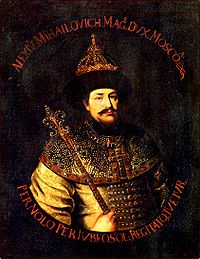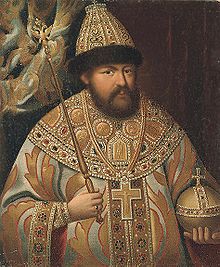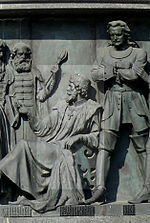- Alexis of Russia
-
Alexis I 
Tsar of All Russia Reign 12 July 1645 - 29 January 1676 (30 years, 201 days) Coronation 28 September 1645 Predecessor Mikhail Successor Feodor III Consort Maria Ilyinichna Miloslavskaya
Nataliya Kyrillovna NaryshkinaIssue Tsarevna Sofia Alexeevna
Fyodor III
Ivan V
Peter I
Tsarevna Natalya AlexeevnaFull name Alexei Mikhailovich Romanov House House of Romanov Father Mikhail Mother Eudoxia Streshneva Born 9 May 1629
MoscowDied 29 January 1676 (aged 46)
MoscowBurial Archangel Cathedral Religion Eastern Orthodox Aleksey Mikhailovich Romanov (Russian: Алексей Михайлович) (9 March 1629 (O.S.) – 29 January 1676 (O.S.)) was the Tsar of Russia during some of the most eventful decades of the mid-17th century. On the eve of his death in 1676, the Tsardom of Russia spanned almost 2,000,000,000 acres (8,100,000 km2).
Contents
Early life and reign
Born in Moscow on 8 March 1629, the son of Tsar Michael and Eudoxia Streshneva, Alexei acceded to the throne at the age of sixteen after his father's death on 12 July 1645. He was committed to the care of the boyar Boris Morozov, a shrewd and sensible guardian sufficiently enlightened to recognize the needs of his country, and by no means inaccessible to Western ideas.
Morozov's foreign policy was pacificatory. He secured a truce with Poland and carefully avoided complications with the Ottoman Empire. His domestic policy was scrupulously fair and aimed at relieving the public burdens by limiting the privileges of foreign traders and abolishing a great many useless and expensive court offices. On 17 January 1648 Morozov procured the marriage of the tsar with Maria Miloslavskaya, himself marrying her sister, Anna, ten days later, both daughters of Ilya Danilovich Miloslavsky (1594–1668).
Morozov was very unpopular however, regarded as a typical self-seeking 17th-century boyar, and was generally detested and accused of sorcery and witchcraft. In May 1648 the people of Moscow rose against them in the so-called Salt Riot, and the young Tsar was compelled to dismiss them and exile Boris to the Kirillo-Belozersky Monastery. Suffering from the forced separation, Alexei sent many tender letters to his mentor, and urged the guards to treat him as civilly as possible.
His associates and policies
The successful issue of the Moscow riots was the occasion of disquieting disturbances all over the tsardom culminating in dangerous rebellions at Pskov and Great Novgorod, with which the government was so unable to cope that they surrendered, practically granting the malcontents their own terms. One man only had displayed equal tact and courage at Great Novgorod, the metropolitan Nikon, who in consequence became in 1651 the Tsar's chief minister.
In 1653 the weakness and disorder of Poland, which had just emerged from the Khmelnytsky Uprising, encouraged Alexei to attempt to annex from her rival the old Rus’ lands. On 1 October 1653 a national assembly met at Moscow to sanction the war and find the means of carrying it out, and in April 1654 the army was blessed by Nikon (now patriarch). The campaign of 1654 was an uninterrupted triumph, and scores of towns, including the important fortress of Smolensk, fell into the hands of the Russians. It was also during this war that Ukrainian Hetman Bogdan Khmelnitsky appealed to Tsar Alexei for protection from the Poles, and got it in the form of the Treaty of Pereyaslav which brought about Russian dominance of the Cossack Hetmanate in Left-Bank Ukraine.
In January 1655 the rout of Akhmatov arrested their progress; but in the summer of the same year, the sudden invasion by Charles X of Sweden for the moment swept the Polish state out of existence; the Russians, unopposed, quickly appropriated nearly everything which was not already occupied by the Swedes, and when at last the Poles offered to negotiate, the whole grand-duchy of Lithuania was the least of the demands of Alexei. Fortunately for Poland, the Tsar and the king of Sweden now quarrelled over the apportionment of the spoils, and at the end of May 1656 Alexei, encouraged by the Habsburg emperor and the other enemies of Sweden, declared war.
Great things were expected of the Swedish war, but nothing came of it. Dorpat was taken, but countless multitudes were lost in vain before Riga. In the meantime Poland had so far recovered herself as to become a much more dangerous foe than Sweden, and, as it was impossible to wage war with both simultaneously, the Tsar resolved to rid himself of the Swedes first. This he did by the Peace of Kardis ( 2 July 1661), whereby Russia retroceded all her conquests. The Polish war dragged on for six years longer and was then concluded by a truce, nominally for thirteen years, which proved the most durable of treaties.
By the Treaty of Andrusovo ( 11 February 1667) Vitebsk, Polotsk and Polish Livonia were restored to Poland, but the infinitely more important Smolensk and Kiev remained in the hands of Russia together with the whole eastern bank of the Dnieper River. This truce was the achievement of Afanasy Ordin-Nashchokin, the first Russian chancellor and diplomat in the modern sense, who after the disgrace of Nikon became the Tsar's first minister until 1670, when he was superseded by the equally able Artamon Matveyev, whose beneficent influence prevailed to the end of Alexei's reign.
When Charles I of England was beheaded by the Parliamentarians under Oliver Cromwell in 1649, an outraged Alexei broke off diplomatic relations with England and accepted Royalist refugees in Moscow. He also banned all English merchants from his country and provided financial assistance to "the disconsolate widow of that glorious martyr, King Charles I." [1]
Assessment
It is the crowning merit of the Tsar Alexei that he discovered so many great men (like Fyodor Rtishchev, Ordin, Matveyev, the best of Peter's precursors) and suitably employed them. He was not a man of superior strength of character, or he would never have submitted to the dictation of Nikon. But, on the other hand, he was naturally, if timorously, progressive, or he would never have encouraged the great reforming boyar Matveyev. His last years, notwithstanding the terrible rebellion of Stenka Razin, were deservedly tranquil.
Alexei's letters have earned him a place in the history of Russian literature, as assessed by D.S. Mirsky:
A few private letters and an instruction to his falconers is all we have of him. But it is sufficient for Sergey Platonov to proclaim him the most attractive of Russian monarchs. He acquired the moniker Tishayshy, which means "most quiet" or "most peaceful". Certain aspects of Russian Orthodoxy, not its most purely spiritual, but its aesthetic and worldly aspects, found in him their most complete expression. The essence of Alexei's personality is a certain spiritual Epicureanism, manifested in an optimistic Christian faith, in a profound, but unfanatical, attachment to the traditions and ritual of the Church, in a desire to see everyone round him happy and at peace, and in a highly developed capacity to extract a quiet and mellow enjoyment from all things.[2]
Family and children
Alexei's first marriage to Miloslavskaya was a success, and she bore him thirteen children in twenty-one years of marriage: five sons and eight daughters, and died weeks after her thirteenth childbirth. Four sons survived her, (Alexei, Fyodor, Semyon, and Ivan) but within six months two of these had died, including Alexei, the sixteen-year-old heir to the throne.
 Tsar Alexei chooses his bride by Grigory Sedov (the result of the Tsardom-wide contest organized by Boris Morozov was his relative Maria Miloslavskaya)
Tsar Alexei chooses his bride by Grigory Sedov (the result of the Tsardom-wide contest organized by Boris Morozov was his relative Maria Miloslavskaya)
Their children were:
- Tsarevich Dmitri Alexeevich (1648–1649)
- Tsarevna Yevdokia Alexeevna (1650–1712)
- Tsarevna Marfa Alexeevna (1652–1707)
- Tsarevich Alexei Alexeevich (1654–1670)
- Tsarevna Anna Alexeevna (1655–1659)
- Tsarevna Sofia Alexeevna (1657–1704)
- Tsarevna Ekaterina Alexeevna (1658–1718)
- Tsarevna Maria Alexeevna (1660–1723)
- Fyodor III (1661–1682)
- Tsarevna Feodosia Alexeevna (1662–1713)
- Tsarevich Simeon (1665–1669)
- Ivan V (1666–1696)
- Tsarevna Yevdokia Alexeevna (1669–1669)
Alexei remarried on 1 February 1671, Nataliya Kyrillovna Naryshkina ( 1 September 1651 – 4 February 1694). She was brought up in the house of Artamon Matveyev and was a ward of his wife, the Scottish-descended Mary Hamilton.
Their children were:
Ancestry
Ancestors of Alexis of Russia 16. Roman Yurievich Zakharyin 8. Nikita Romanovich Zakharyin-Yuriev 17. Juliana Fedorovna Karpova 4. Feodor Nikitich Romanov, Patriarch Philaret 18. Ivan Vladimirovich Golova Khovrin 9. Varvara Ivanovna Golovina-Khovrina 19. Anna Danilovna Cholmskaya 2. Michael I of Russia 5. Xenia Shestova 1. Alexis of Russia 12. Stepan Streshnyov 6. Lukyan Stepanovich Streshnyov 3. Eudoxia Streshneva 28. Roman Alexandrovich Volkonsky 14. Konstantin Volkonsky 7. Anna Konstantinovna Volkonskaya See also
- Tsars of Russia family tree
Notes
- ^ Massie, Robert K. Peter the Great: His Life and World. Knopf: 1980. ISBN 0-394-50032-6. Page 12.
- ^ D.S.Mirsky, A History of Russian Literature. Northwestern University Press, 1999. ISBN 0-8101-1679-0. Page 27.
References
- Grigory Kotoshikhin's On Russia during the reign of Alexey Mikhailovich (1665) is a key source on domestic life of the tsar and his court.
- Yury Krizhanich's treatises from 1660s are also very informative.
Regnal titles Preceded by
Michael ITsar of Russia
1645–1676Succeeded by
Feodor IIIRussian royalty Preceded by
Feodor RomanovHeir to the Russian Throne
1629–1645Succeeded by
Alexei AlexeevichTsareviches of Russia 1st generation (Rurikids) - Dmitri Ivanovich
- Ivan Ivanovich
- Feodor I Ivanovich
- Vasili Ivanovich
- Dmitry Ivanovich
2nd generation (Rurikids) - none
1st generation (Godunovs) 1st generation (Romanovs) - Alexei I Romanov
- Ivan Mikhailovich
- Vasili Mikhailovich
2nd generation (Romanovs) - Dmitri Alekseyevich
- Alexei Alekseyevich
- Feodor III Alekseyevich
- Simeon Alekseyevich
- Ivan V Alekseyevich
- Peter I Alekseyevich
3rd generation (Romanovs) - Ilya Fyodorovich
- Alexei Petrovich
- Alexander Petrovich
- Paul Petrovich
- Peter Petrovich
- Paul Petrovich
- Peter Petrovich
 This article incorporates text from a publication now in the public domain: Chisholm, Hugh, ed (1911). Encyclopædia Britannica (11th ed.). Cambridge University Press.
This article incorporates text from a publication now in the public domain: Chisholm, Hugh, ed (1911). Encyclopædia Britannica (11th ed.). Cambridge University Press.
Categories:- Russian tsars
- Candidates for the Polish elective throne
- House of Romanov
- People from Moscow
- 1629 births
- 1676 deaths
- Orthodox monarchs
- 17th-century Russian people
Wikimedia Foundation. 2010.





